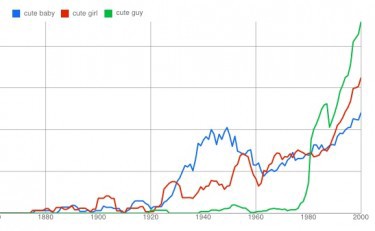The Birth of Cute
by Liora Halperin

We use the word all the time, maybe assuming it is one of those old Anglo-Saxon monosyllables. But it is really a fairly recent term. CUTE is a shortened form of ACUTE, which means sharp (like an acute angle, as we learned in geometry) or clever (we use the word ‘sharp’ to mean smart as well). In the 18th and 19th centuries CUTE, which was initially written with an apostrophe in the beginning to stand for the missing A, meant clever or smart. So, for example, when the Manchester Evening Mail wrote in 1882 that “American girls, in fact, appear to be as cute as the masculine Yankee,” it wasn’t saying that you would want to pinch their cheeks and talk with them in baby-talk, or even that they were attractive: it was a statement about their personality and smarts. To some extent we still use the term that way, for example when we sarcastically use the phrase “That’s cute” to refer to something that is overly or irritatingly clever.
In the late 19th/early 20th century, the meaning shifted, particularly in the US, to a somewhat more aesthetic one: “attractive, pretty, charming.” It first had the sense of smart in the sense we mean when we say that someone is “smartly dressed”: precisely, with good taste, or “just so.” Overtime these associations of precision and care were also connected to small size. The London Daily News wrote in 1900 of “A small and compact wooden house, what the Americans would call ‘cute.’”
The aesthetic sense has largely taken over, now almost always connected to things that we find attractive because of their youth or smallness: we use it chiefly to refer to babies (we are all but obliged to use this term upon meeting one), small animals (the cutest of which get whole websites devoted to them) and, what may be an outgrowth from the old usage, objects of teenagers’ or young people’s romantic attraction, usually on the basis of appearance alone. Teen magazines really like this one. Google’s N-Grams site, which aggregates its millions of pages of scanned books into a fun search engine, allows us to see when these usages came into widespread use. The 1920s or so is really the beginning of it being used widely (at least in print) to describe babies, kitties, small animals, and attractive young women. “Cute guy,” though, didn’t take off until the 1970s.
Liora Halperin is an Assistant Professor of Near Eastern Studies and Judaic Studies at Princeton. She writes about language and history and particularly enjoys discovering interesting word origins.